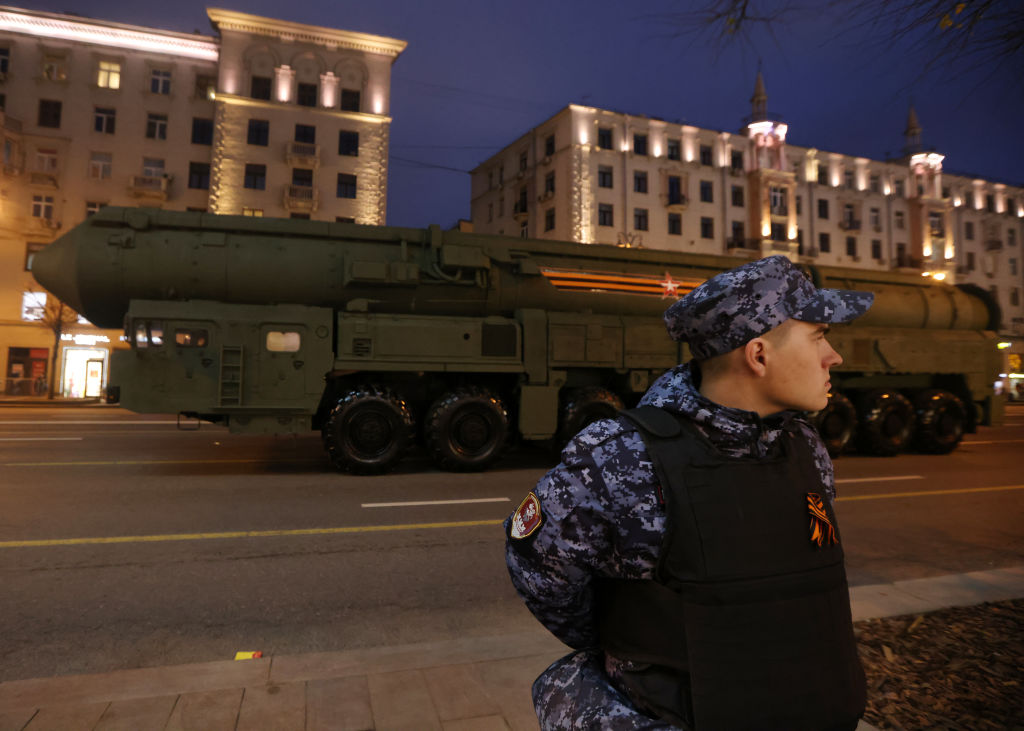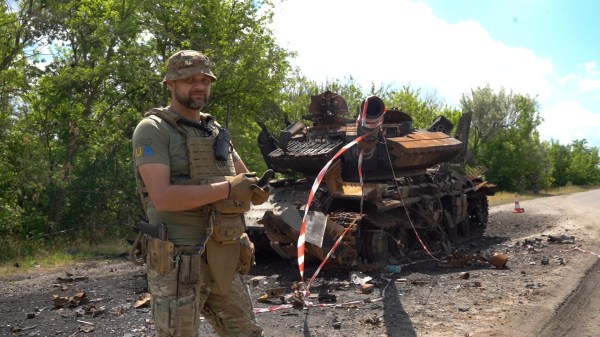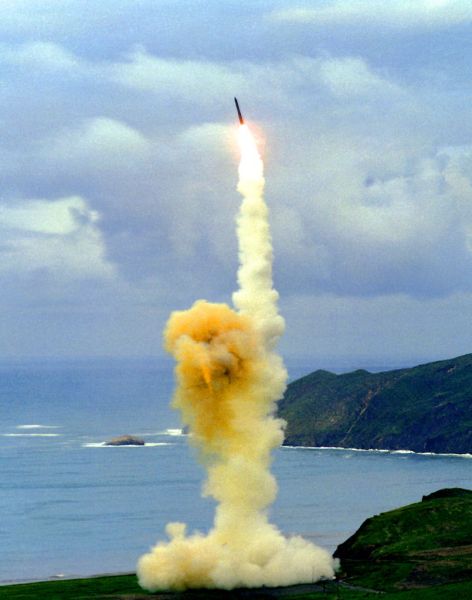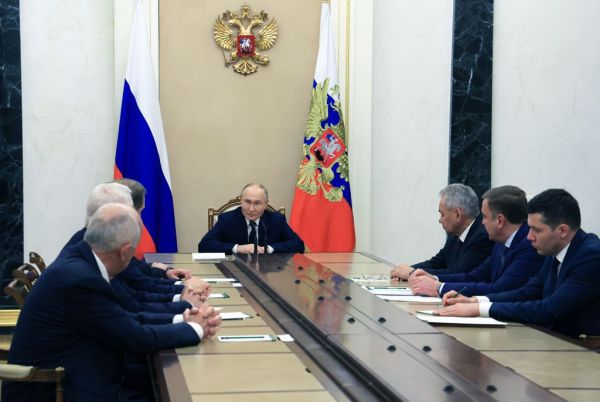Russian President Vladimir Putin’s recent announcement of military rehearsals for the deployment of tactical nuclear weapons in response to NATO’s support of Ukraine is only the latest in a series of hints, statements, and threats from the Russian government intimating a willingness to “go nuclear.”
But the characterization of these weapons as “tactical” as opposed to “strategic” is a holdover from Cold War terminology that has little applicability to today’s interconnected world, where the use of any nuclear weapon would have immediate and profound strategic consequences.
What is a tactical nuclear weapon?
Nuclear weapons are often categorized based on range, yield, and delivery method. Tactical nuclear weapons are generally described as relatively low-yield, short-range weapons delivered by battlefield systems such as artillery or tactical aircraft. Although exact definitions vary, yields can be less than 1 kiloton (kt) to upward of 100kt (for comparison, the Hiroshima and Nagasaki bombs were 15kt to 23kt), with ranges in the dozens to low hundreds of miles. This compares to theater or strategic systems, which are delivered by missiles or long-range bombers and have megaton (mt) yields with ranges measuring thousands of miles.
During the Cold War, these limited-yield weapons served to address military challenges for which NATO and the Soviet Union had no conventional response. Leaving weapons in storage, deploying them to battlefields and air bases, or mating them to delivery systems (loaded on aircraft or placed on artillery shells, for example) sent a strong message about how seriously a crisis or conflict was being taken by either side. This is the psychology of escalation that Putin is employing now, but is more applicable to a Cold War world with two distinct blocs and controlled information than today’s multipolar and interconnected world.
While the thought of using a nuclear weapon to destroy a tank formation seems nearly inconceivable today, the doctrine behind these weapons was developed by tacticians with living memories of two world wars and millions of casualties inflicted by both conventional and non-conventional arms. For someone who learned to duck and cover near the missile fields of Montana, Wyoming, or North Dakota, nuclear war was anything but unthinkable. Enormous intellectual capital went into formulating plans and doctrine for not just surviving but ultimately prevailing in a Cold War nuclear conflict.
Who possesses tactical nuclear weapons, and why?
First, a caveat: All of these numbers are open to debate and even questionable at the unclassified level because nations closely guard such information. But they do provide orders of magnitude for useful comparisons. The Center for Strategic and International Studies has compiled data consistent with numbers and capabilities presented below along with important caveats here.
The question of “who has what” perfectly illustrates why the term “tactical nuclear weapon” has outlived its usefulness. There are estimated to be more than 12,000 nuclear weapons in the nine declared and undeclared nuclear states. The United States is currently reducing its stockpile. French and Israeli stockpiles are relatively stable. And China, India, North Korea, Pakistan, and the United Kingdom, as well as possibly Russia, are thought to be increasing their stockpiles.
Of the more than 12,000 weapons, a little less than 20 percent can be categorized as non-strategic or tactical based on their sizes, ranges, and/or delivery mechanisms. Russia has by far the most tactical nuclear weapons with more than 1,500. The U.S. has 100 stored in Europe, and likely more stored on the U.S. mainland. India, Pakistan, North Korea, and Israel are estimated to have a little fewer than 500 among them. But Israel, India, North Korea, and Pakistan certainly don’t consider their “tactical” weapons as means to achieving tactical ends. The weapons exist to advance the strategic goals of regime survival or the threat of inflicting unacceptable punishment on potential adversaries.
So depending on where one sits, weapons with similar characteristics can be either tactical or strategic. The defining characteristic is in the objective, not the weapon. A nuclear state’s doctrine will define how it intends to translate means into ends, but it’s the ends that determine whether any military action is tactical, operational, or strategic.
Unfortunately, nuclear doctrine is not always clear. All nuclear states intentionally maintain some level of ambiguity in their statements about when and how they would use their nuclear arsenals to inject doubt into a potential adversary’s cost/benefit calculations and provide maneuvering room during a crisis. China and India, for example, have articulated so-called no first-use doctrines. In truth, it’s anybody’s guess whether they would adhere to their “no first use” rhetoric in an existential crisis. Russia explicitly states that it will use nuclear weapons to achieve its war objectives or to protect its sovereignty if it’s threatened. Israel doesn’t acknowledge its weapons, much less any doctrine.
U.S. nuclear doctrine is outlined by the Defense Department in periodic Nuclear Posture Reviews, the latest of which was published in 2022. It describes the role of nuclear weapons in U.S. policy as deterring strategic attacks, assuring allies and partners, and achieving U.S. objectives if deterrence fails. The underlying theme is a strategy of deterrence: having a strong and survivable enough arsenal to deter any potential adversary from using nuclear or other weapons of mass destruction against the United States or its allies. As simple as that sounds, it’s a policy that evolved over decades, just as technologies and adversaries have evolved.
Lower-yield nuclear weapons used for limited objectives are not necessarily considered as part of an escalation ladder leading to all-out nuclear war between major powers. If the use—or even threatened use—of such weapons either enables a decisive win or deters a decisive defeat, they could even be considered de-escalatory. This is certainly part of Russia’s strategy of provocation. It has an explicit “escalate to de-escalate” strategy that seeks to end fighting on its terms by threatening to take measures—including nuclear—the consequences of which are unpredictable.
But nobody really knows how or how quickly things might escalate once the taboo of using a nuclear weapon is broken. Command and control breakdowns could result in unauthorized use. Misinterpreted intentions could lead to further escalation. Other regional nuclear powers could see a superpower’s use of nuclear weapons as a green light to solve their own local conflicts using the same means. In today’s connected world, it is difficult to envision a scenario where nuclear weapons of any size could be used for any limited purpose and not have consequential strategic effects on all involved, and even many who are not.
Is any nuke really tactical?
Would a tactical nuclear weapon even be effective if used to achieve tactical, i.e. battlefield ends? That depends on the battlefield. Will friendly troops be required to travel through a contaminated zone? How would civilians and civilian infrastructure be affected? There are certainly cases where a small nuclear blast could destroy a target more quickly and efficiently than masses of conventional weapons and personnel. But despite any temporary tactical gains, its use would send a strategic message to the adversary and to the world. But such a message will almost certainly result in a strategic response, whether by military or other elements of national power. Not necessarily a like response, but one designed to have strategic impacts. So yes, nuclear weapons can have tactical effects. But these effects will be overshadowed by a much larger strategic fallout.
War, it’s been said, is politics by other means. With nuclear or any other kind of weapons, whether those means are tactical or strategic depends on the objectives a nation is trying to achieve, not the damage it’s trying to do. Any nuclear detonation in a wartime environment would likely be for the furtherance of strategic objectives and almost certainly would result in strategic consequences. The term “tactical nuke” will almost certainly continue in use but should be thought of only as a reference to size and range, not desired outcomes.









Please note that we at The Dispatch hold ourselves, our work, and our commenters to a higher standard than other places on the internet. We welcome comments that foster genuine debate or discussion—including comments critical of us or our work—but responses that include ad hominem attacks on fellow Dispatch members or are intended to stoke fear and anger may be moderated.
With your membership, you only have the ability to comment on The Morning Dispatch articles. Consider upgrading to join the conversation everywhere.